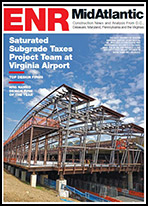The construction team also had to be mindful not to interfere with the numerous experiments under way at the Rice Center. Before silt fences could be placed, for example, the team worked with researchers to ensure that nothing would hinder the free movement of turtles, which are monitored using high-tech radio tracking technology.

KBS LEED coordinator Stephanie Walzer adds that because construction practices go a long way toward accumulating LEED credits, strict discipline was necessary to preserve all points typically associated with contractor activities, such as recycling and indoor air quality.
“Many of our subs are new to LEED, so we had to continually make sure the correct materials went into the recycling dumpsters, nobody smoked within 50 ft of the building and that nothing but approved low-VOC materials were brought onsite,” she says.
The team’s diligence yielded a 69% recycling and reuse rate for construction waste materials, which Williams says is impressive for a nonurban site that typically involves substantial demolition work.
Self-contained sustainability. To keep the building in balance with its sensitive surroundings, the project team incorporated an innovative combination of vegetated roofs and rain gardens, French drains and bioretention cells to treat all runoff from impermeable surfaces onsite.
For the serpentine entrance road, a permeable stone pavement tops a plastic grid reinforcement system that supports large vehicles such as fire trucks. Stormwater passes through the stone pavement and into the void spaces of larger underlying stone, where it is collected in an underdrain pipe that feeds the bio-retention cells.
Owner: Virginia Commonwealth University, Richmond
General Contractor: KBS Inc., Richmond
Architect: Train & Partners Architects, Charlottesville, Va.
Civil Engineer: Draper Aden Associates, Richmond Sustainability: Sustainable Design Consulting, Richmond
Sitework: Bruce Howard Contracting, Providence Forge, Va. Mechanical: Town & Country Mechanical, Richmond
Electrical: C. E. Towler Inc., Midlothian, Va.
Plumbing: Colonial Plumbing & Heating Co., Colonial Heights, Va. Concrete: Concrete Concepts, Newport News, Va.
Masonry: RM Masonry Brick Contractors, Richmond
Carpentry: H.Beckstoffers Sons Inc., Richmond
Roofing: Roof Systems of Virginia, Richmond
Landscaping: Stockners Rockville, Rockville, Va.
The road’s stone type and brown color were selected to accommodate ADA and permeability requirements and to reduce heat island effects.
And with no nearby sanitary sewers, an environmentally sound onsite wastewater treatment solution was also needed.
“We developed a system that combines a package treatment system, sand filters and ultraviolet light disinfection, then pipes the sewage to a spray irrigation discharge system,” says Dave Tiller, project manager for civil engineer Draper Aden of Richmond.
The system can also be modified to accommodate other discharge methods, “allowing students to study their effects on the environment,” Tiller adds.
Completed in October 2008, the Rice Education Center is already receiving some sustainability assistance from the area’s animal population. The project team worked with the state Department of Game and Inland Fisheries to select a seed mixture for the grid-reinforced grass parking spaces that will prove tasty to deer and other animals—and help keep the spaces evenly trimmed in the process.
Olinger says such creativity is what truly helps set the project apart.
“We were doing things with that building that we hadn’t tried before,” he says. “That’s why building the right team that understands building to LEED standards is so important. In some respects, it’s the hardest part of any project.”

